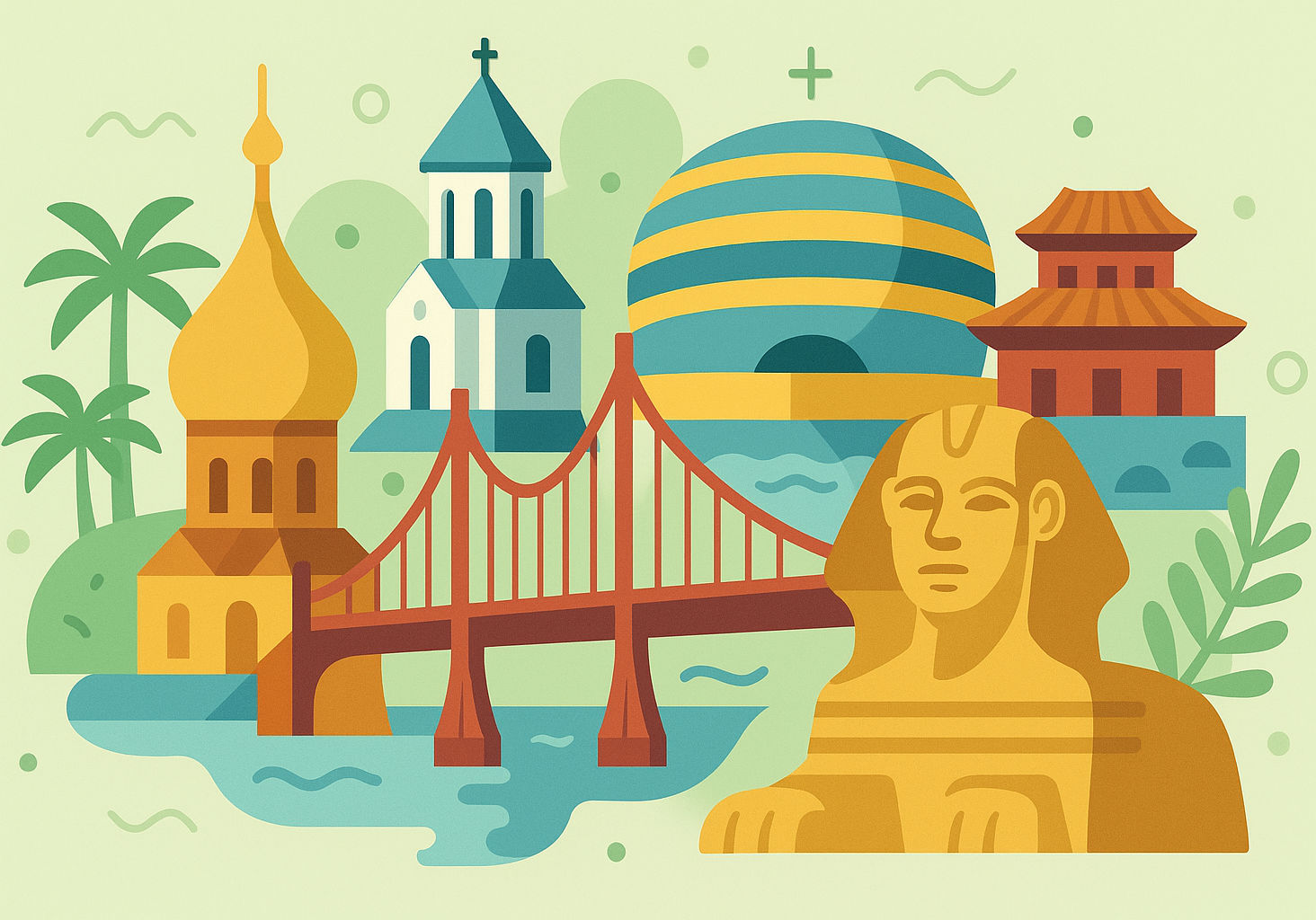Top 10 Landmarks in Europe Every Traveler Should See
June 25, 2025
Europe is a continent steeped in culture, history, and architectural brilliance, making it a haven for travelers seeking meaningful and awe-inspiring experiences. From ancient ruins that whisper tales of empires to modern marvels that showcase human innovation, the top landmarks in Europe offer unforgettable memories and stories that stay with visitors for a lifetime. Whether you're wandering through cobbled city centers or hiking through rugged mountain landscapes, you’ll find that Europe’s most iconic landmarks offer much more than just picturesque photo opportunities.
Each landmark on this list has achieved global fame, not only for its aesthetic or historical significance but also because of the unique emotion and energy it brings to those who visit. These are places where the past meets the present, where travelers feel connected to the spirit of exploration and discovery. As you plan your itinerary, knowing which famous European landmarks are truly worth your time can help you get the most out of your journey.
This guide highlights ten must-see landmarks across the continent — from Western Europe’s cultural capitals to the architectural gems of Central and Eastern Europe. Whether you're a history buff, an architecture enthusiast, or simply someone with a curiosity for the world's wonders, these destinations are bound to leave a deep impression. Let’s explore the most legendary and significant European landmarks every traveler should visit at least once.
10. Bran Castle – Transylvania, Romania

Nestled in the Carpathian Mountains, Bran Castle is one of Eastern Europe’s most intriguing landmarks, often associated with the Dracula legend. While there’s no historical evidence that Vlad the Impaler lived here, the fortress’s dramatic location and gothic appearance make it a favorite among travelers seeking both history and folklore.
The castle dates back to the 14th century and features winding staircases, narrow corridors, and antique-filled rooms that transport visitors back to medieval times. The museum inside explores both the castle’s real history and its literary connections to Bram Stoker’s Dracula.
Surrounding the castle is a picturesque village where visitors can sample local cuisine and shop for handmade crafts. The misty hills and pine forests complete the mysterious ambiance. Bran Castle is a must-see landmark in Europe for those drawn to legends, mystery, and striking scenery.
9. Schönbrunn Palace – Vienna, Austria

Once the summer residence of the Habsburg dynasty, Schönbrunn Palace is one of Europe’s most majestic Baroque landmarks. With its 1,441 rooms, sprawling gardens, and opulent interiors, the palace offers a glimpse into royal life during the Austro-Hungarian Empire.
Visitors can explore the Grand Tour, which includes the imperial apartments of Empress Maria Theresa and Emperor Franz Joseph. Each room is lavishly decorated with chandeliers, gold accents, and historical portraits that tell the story of a bygone era. The palace grounds are equally impressive, featuring formal gardens, fountains, a palm house, and even a zoo — one of the oldest in the world.
Attending a classical concert inside the palace or strolling through the maze in the gardens adds a magical touch to the experience. For travelers interested in art, music, and royal history, Schönbrunn Palace is one of the top cultural landmarks in Europe to explore.
8. Charles Bridge – Prague, Czech Republic

Spanning the Vltava River in the heart of Prague, the Charles Bridge is a medieval masterpiece and a defining European landmark. Completed in the 15th century under the rule of King Charles IV, the bridge connects the Old Town with the Lesser Town and offers a walking experience like no other.
Lined with 30 baroque statues and dotted with street performers and vendors, the bridge is both a historical artifact and a lively gathering place. Early mornings offer a peaceful stroll without the crowds, while sunset brings a golden glow that enhances the romantic atmosphere.
The towers at either end of the bridge provide elevated views of the city and its red-roofed skyline. The nearby areas are filled with quaint cafes, artisan shops, and centuries-old churches, making it a perfect spot for exploration. Charles Bridge is not just a crossing but a destination in itself, offering one of the most scenic and soulful experiences in Europe.
7. Neuschwanstein Castle – Bavaria, Germany

Straight from a fairy tale, Neuschwanstein Castle is one of Europe’s most picturesque landmarks. Perched on a rugged hill in Bavaria, this 19th-century Romanesque Revival castle was commissioned by King Ludwig II of Bavaria and later inspired Disney’s Sleeping Beauty Castle. Its towers, balconies, and mountainous backdrop create a dreamlike setting that draws visitors year-round.
The interior of the castle is equally stunning, featuring opulent rooms with intricate woodwork, murals depicting Wagnerian operas, and a throne room fit for royalty. Guided tours reveal fascinating insights into King Ludwig’s reclusive life and his obsession with fantasy and art.
The castle is most accessible via the town of Füssen, with shuttle buses or a scenic hike leading up to its entrance. Nearby Marienbrücke offers one of the best photo spots, providing a sweeping view of the castle against the forested mountains. Neuschwanstein Castle is one of the most visited landmarks in Europe and a must-see for lovers of fantasy, history, and architecture.
6. Stonehenge – Wiltshire, England

Mysterious and ancient, Stonehenge stands as one of Europe’s most intriguing prehistoric landmarks. Located in the English countryside, this circle of massive standing stones has puzzled archaeologists and historians for centuries. Dating back over 4,000 years, it is believed to have served as a ceremonial or astronomical site, though its true purpose remains the subject of ongoing debate.
Visitors to Stonehenge can walk along a designated path that encircles the stones, with an audio guide providing historical context and theories about its construction and use. The nearby visitor center includes reconstructed Neolithic houses and engaging exhibits that help place the monument in its broader historical and cultural context.
The experience of seeing Stonehenge up close is hauntingly beautiful, especially at sunrise or sunset when the stones cast long shadows across the open plain. The wind rustling through the fields adds a sense of timeless solitude. For those interested in Europe’s ancient past and unsolved mysteries, Stonehenge is an essential landmark to include on your travel list.
5. Sagrada Família – Barcelona, Spain

Barcelona’s skyline is dominated by the otherworldly towers of the Sagrada Família, a basilica unlike any other in the world. Designed by the visionary architect Antoni Gaudí, this ongoing masterpiece has been under construction since 1882 and remains a top landmark in Europe for architecture lovers. Its combination of Gothic and Art Nouveau styles, infused with Gaudí’s unique organic vision, makes it a breathtaking spectacle inside and out.
The basilica’s intricate facades tell stories from the Bible with unparalleled detail, each side revealing a different narrative. Inside, the colorful stained glass windows create a kaleidoscope of light that shifts throughout the day, adding to the spiritual ambiance. A guided tour offers insights into the symbolism, engineering, and natural inspirations behind Gaudí’s design.
Located in the heart of Barcelona, the area surrounding the basilica is lively with cafes and local shops. Early morning or late afternoon visits tend to offer the best light for photography. More than just a religious site, the Sagrada Família is a cultural emblem of Catalonia and one of the most fascinating landmarks in Europe to witness in person.
4. Big Ben and the Houses of Parliament – London, England

Standing proudly along the River Thames, Big Ben and the Houses of Parliament are among the most iconic landmarks in Europe. Although commonly called Big Ben, the name technically refers to the bell inside the Elizabeth Tower. Together with the gothic splendor of the adjoining Palace of Westminster, this architectural ensemble represents centuries of British political history and grandeur.
Whether viewed by day under crisp blue skies or at night when the clock tower glows golden, the silhouette of Big Ben is instantly recognizable. Visitors often enjoy walking the Westminster Bridge for a full view of the building, or catching a river cruise for a unique perspective. While the interior is currently not open to general tourists, the external views and nearby sites such as Westminster Abbey and St. James’s Park make this area a hub of cultural exploration.
As the seat of British democracy, this site holds tremendous symbolic importance and offers photo opportunities at nearly every angle. A stroll through this area is essential for understanding both the past and present of the United Kingdom. Big Ben remains a must-see European landmark for first-time and returning travelers alike.
3. Acropolis – Athens, Greece

Rising majestically above Athens, the Acropolis is a symbol of ancient Greece and a cornerstone of Western civilization. This hilltop citadel features some of the most iconic ruins in the world, including the Parthenon, a temple dedicated to the goddess Athena. Built in the 5th century BC, the Acropolis showcases the pinnacle of classical Greek architecture and philosophical achievement.
Climbing to the top rewards visitors with sweeping views of the sprawling city below and the Aegean Sea on the horizon. Every stone and column tells a story of art, democracy, and the birth of modern thought. At sunset, the golden light casts a mythical glow over the marble structures, creating a spiritual and unforgettable atmosphere.
A visit to the adjacent Acropolis Museum enhances the experience by displaying artifacts and explaining the history behind the architecture. Wandering the narrow streets of Plaka at the base of the hill completes the journey, with traditional tavernas, live music, and artisan shops adding to the charm. The Acropolis is a European historical landmark that every traveler with a love of history should explore.
2. Colosseum – Rome, Italy

Few landmarks are as awe-inspiring or as steeped in legend as the Colosseum in Rome. This ancient amphitheater, constructed in the first century AD, once hosted gladiatorial contests, dramatic performances, and public spectacles attended by tens of thousands. As one of the greatest architectural feats of the Roman Empire, it stands as a testament to their engineering prowess and cultural impact.
Walking through the ruins today, visitors can almost hear the roar of the crowds and visualize the spectacles that once unfolded within its walls. It’s a profound experience that connects you directly to the heart of Roman civilization. Guided tours often include access to the underground chambers and the upper tiers, providing an even deeper appreciation of the structure.
The Colosseum is situated near other significant Roman landmarks like the Roman Forum and Palatine Hill, making it a central point for exploring the ancient city. Early morning visits are ideal to beat the crowds and the summer heat. A visit to this legendary site is not just a sightseeing stop — it’s a journey back in time. For anyone passionate about history or architecture, the Colosseum is one of the top landmarks in Europe that cannot be missed.
1. Eiffel Tower – Paris, France

Standing tall above the Paris skyline, the Eiffel Tower is the most recognized landmark in Europe and a symbol of romance, elegance, and innovation. Built for the 1889 World’s Fair, this iron masterpiece designed by Gustave Eiffel was initially met with controversy but soon became a beloved icon of France. Today, it attracts millions of visitors annually who come to admire the panoramic views, especially at night when it sparkles with thousands of lights.
Visitors can explore the tower’s different levels, with the summit offering a particularly breathtaking perspective of Paris. The surrounding Champ de Mars park is perfect for a leisurely picnic or stroll, providing one of the best photo spots in the city. Street performers, crepe vendors, and open-air artists add to the vibrant energy of the area.
Beyond the tower itself, the experience encapsulates the very essence of Parisian charm. From sipping espresso at a nearby café to cruising the Seine River just a few steps away, this is one of those places where the magic of travel truly comes alive. For anyone visiting France, the Eiffel Tower is a European landmark you absolutely must see.
Final Thoughts
The landmarks featured in this guide represent just a glimpse of the vast and rich heritage that Europe has to offer. Each site holds stories that span centuries, architectural marvels that defy time, and cultural symbols that unite people from around the world. Whether you’re gazing up at the Eiffel Tower, walking across the Charles Bridge, or exploring the ruins of the Acropolis, these experiences enrich your understanding of the world and inspire deeper appreciation for its history.
Traveling through Europe is not just about checking off destinations; it’s about connecting with places that have shaped civilizations, ignited creativity, and sparked the imagination of millions. These top landmarks in Europe are more than just attractions — they are gateways to unforgettable journeys.
So as you plan your adventures, consider the stories behind each of these landmarks. Let them guide your footsteps, fuel your curiosity, and remind you that the world is full of wonders waiting to be discovered. In the end, it’s these places — rich in character, history, and beauty — that make European travel so uniquely rewarding.


